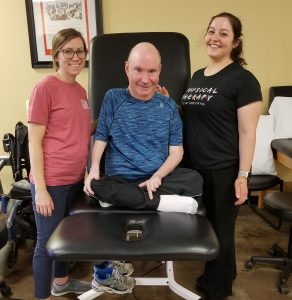Advancements in Wheelchair Options

As we have previously discussed in earlier articles, wheelchairs play a main role in the daily lives of many patients with SMA. Over the past ten years, wheelchairs have changed for the better, and now have many customizable options available that can very much benefit the patient. Things such as that ability to be able to raise and lower your chair, can make things more accessible for patients who can now sit at taller tables and speak with someone at their own eye level. These victories can make such a difference in the lives of any person who may require a wheelchair.
My patient, Michael, has had the same wheelchair for many years, and his chair has little to none of the new upgrades. He will be receiving a new chair within the next month that will have many upgrades, including feet rests, that will take some getting used to, but will show to be very beneficial for Michael and his daily life. To receive a new chair, there is a representative that comes into our physical therapy clinic and sits with a DPT to take specific measurements, such as hip width, chair depth, and height of chair, and discuss what his options are for a new chair. We then all sat and discussed his options and what we suggest he should opt for and why, but ultimately, the choice is what he feels that is best for him and what he will benefit from. There are many options out there, but just like anything, every person is built differently and has different daily activities, requiring different equipment. All of this must be considered when ordering specifics for a patient and their chair.
In the past, Michael has had a sling back and a sling seat, which are no longer options for new chairs for many reasons. We have ordered a chair that has a three-inch cushion with a gel pad for the seat, to disperse the weight out equally and decrease the pain in his right hip, where he has nerve damage. Like I mentioned previously, he will now have footrests, unlike the chair he is currently using. These will be fully adjustable and will help to improve the lack of motion in his ankles, as well as work to reduce the edema in Michael’s ankles and feet. His footrests will also be fully adjustable, allowing for more comfort when first beginning to wear feet rests again, and will continue to aid in decreasing edema.
The ability to tilt and recline his chair is another option we have opted for in Michael’s new chair. Tilting will allow him to perform weight shifting off of his bottom and more onto his back, which will be very useful for Michael when he begins to have pain in his hip that he is suffering from nerve damage in. Reclining means that he will be able to transition to a more supine position, which is again good for weight shifting. as well as to incline his feet to decrease edema in his feet and ankles. These options will allow for more positional options and comfort throughout his day.
There are other features that will also help to make his daily life easier, such as that ability to increase his seat height up to 12 inches, allowing more independence in obtaining items that may sit as a higher level, as well as ability to be more at the level of other people when they are standing. This chair also has the ability to perform assisted reaching, which means the chair will be able to tilt forward, allowing for more independence in gaining access to items he may need throughout his day.
Another advancement this chair has is the ability to use Bluetooth for his phone, allowing him to control his phone with his joystick. This will also help to improve his independence and ease throughout daily activities. Michael will also be able to use a USB connection on his chair to charge items such as his phone and his computer.
There have been many advancements in wheelchair customization over the years. Many of these are necessary to activities of daily living. While some of these allow for more independence, Michael will also have the ability to take part in the more technology advanced world that we all live in.
======================== Patient Perspective ========================

Throughout my life, I’ve used wheelchairs of various styles and models. I first used a manual chair, and would either push myself around or rely on friends and family to help me maneuver. When I was 15 years old, my parents purchased me my first electric wheelchair. After using it for just a few minutes, I realized the freedom that this chair would provide me with, as I would no longer have to depend on others to get me from point A to point B. While that first electric chair was nothing more than a manual chair with two motors, it gave me a chance to experience life without always having someone there to accompany me. To say that this was liberating would be an understatement.
Along the way, I developed a few bad habits that have now caused me problems in my adult life. I quit using foot rests, because it made it too difficult for me to get close enough to open doors, and to get underneath desks at school. Quite a few people told me that I should use these to avoid problems with my ankles, but what did they know? I was 15, and I knew everything!!
Also, every wheelchair I’ve used has had sling seats and sling backs. Throughout the years, the sling seats caused my hips to rotate inward, which resulted in problems with my posture. Now that I’m older, and realized that I should have listened to others, I’m in the market for a new electric wheelchair. This process comes with its own set of challenges.
For starters, all of the wheelchair manufacturers have moved away from using sling seats and backs, and have switched to using hard pan seats. After demoing a few of these chairs, I quickly realized that my body was not going to like these changes. With the right type of seating arrangement, and the proper cushion, I’m hopeful that my body will adapt.
Even though it’s going to be a challenge, I know that this is something I have to do. When I first started physical therapy in October 2017, my physical therapists asked me why I wasn’t wearing foot rests. While they understood my explanation, they also told me that this was the reason why my ankles and feet had so much edema and swelling. Then, when I told them that I was interested in purchasing a new wheelchair, they made it perfectly clear that this new chair must include foot rests. Now that I’m older, and I hope somewhat wiser, I decided that their advice was something that I needed to listen to.
Wheelchair models of the past were basically a frame and four wheels. None had any kind of reclining or adjustment capabilities. Now, electric wheelchairs have the ability to adjust a user’s leg position, recline, tilt back, and lean forward. These newer models can also connect to smartphones and USB devices, allowing users to use them for functions beyond basic mobility. While it’s somewhat overwhelming to see how technology has changed in my lifetime, it’s also exciting to know that these advancements give those of us in wheelchairs the opportunity to connect with the world around us.
After being evaluated by a certified ATP, along with my physical therapists, I’m ready to order my new chair. While I’m apprehensive, I’m also excited about the benefits that this new chair will provide me with. Am I nervous? Yes. Am I scared? Absolutely. Will this new wheelchair make me look like Arnold Schwarzenegger? Even at the age of 54, I can still dream!

